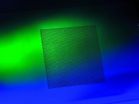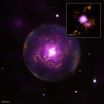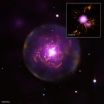(Press-News.org) The computer activates an alarm: the machine's motor is threatening to overheat. The thermosensor attached directly to the motor housing reports the threat. The information is transmitted to the maintenance service which ensures that the cause is identified. Sensors can be used in factories, car manufacturers and other areas in everyday life. They measure temperature, humidity and wear and tear. Data is transmitted to the computer via wireless communication and read out. This enables the provision of information on the condition of parts – for instance, whether maintenance or repairs are required. More and more frequently wireless sensors are used which consume very low levels of energy and the power required by the sensor, the processing unit and wireless module derives its power directly from the environment instead of "harvesting" energy from batteries Electrical energy can be generated, for instance, from heat or movement. Researchers from the Fraunhofer Institute for Manufacturing Technology and Advanced Materials IFAM in Bremen will be presenting a printed thermogenerator, which can be tailored exactly to technical interfaces, at the Electronica trade fair in Munich (13 – 16 November) Hall A5, Booth 121.
Monitoring with energy-autonomous sensors
"Wireless sensor networks facilitate the monitoring of safety-related components", explains Dr. Volker Zöllmer, Head of Functional Structures, whose work focuses on the topic of Energy Harvesting at the Fraunhofer IFAM. For sensors to work at optimum capacity, they must be attached directly to the component's interface or even integrated into the component. The power supply is usually obtained via cable or battery. "However, the limited storage capacity and battery life, as well as the issue of recycling, are critical subjects for the user", appreciates Zöllmer. "In our experience, a replaceable battery contributes significantly to the design of an application and as such restricts the flexible layout".
To ensure that the sensor network is entirely suitable for energy supply by means of energy harvesting, it must only consume low levels of energy. If sensors in intelligent networks are only active when sending and receiving data, energy is only required in milliwatts. Thermogenerators can deliver these quantities, for example, converting ambient heat into power. The IFAM researchers use new production processes to custom manufacture such generators.
Printing thermogenerators
"Generative manufacturing processes produce both sensors and sensor networks as well as the required elements for energy harvesting such as thermogenerators: By directly depositing functional structures, which have an ink or paste base, using ink-jet, aerosol-jet, screen-printing or dispensing processes, not only can electrical circuit boards and sensor elements be attached to different interfaces but it is also possible to produce structures which harvest energy", explains Zöllmer. Using a purposeful combination of metallic and thermoelectrical materials which are successively applied, the researchers manufacture structures which can be used as thermoelectrical generators. The major advantage of this is that the printed thermogenerators can be tailored exactly to the technical surfaces. This makes the sensors less susceptible to faults because the energy supply can be adapted directly to the respective requirements.
INFORMATION:
Thermogenerator from the printer
2012-11-15
ELSE PRESS RELEASES FROM THIS DATE:
GW Research chosen as 'paper of the week' for blood coagulation discovery
2012-11-15
WASHINGTON (Nov. 15, 2012) – Researchers at the George Washington University School of Medicine and Health Sciences (SMHS) will be featured as a top paper in next week's issue of the Journal of Biological Chemistry. Research by Rakesh Kumar, Ph.D., Catharine Birch McCormick Endowed Chair of the Department of Biochemistry and Molecular Biology and professor of biochemistry and molecular biology, and Beatriz Sánchez-Solana, postdoctoral fellow at the department of biochemistry and molecular medicine, both at SMHS, has been selected as the journal's "Paper of the Week". The ...
President's Bioethics Commission posts Study Guide
2012-11-15
Washington, D.C. – The Presidential Commission for the Study of Bioethical Issues today released an ethics study guide based on the Commission's investigation into the U.S. Public Health Service (PHS) experiments conducted in Guatemala in the 1940s. A Study Guide to "Ethically Impossible" STD Research in Guatemala from 1946 to 1948 is designed for use by higher education and other interested members of the public. It is free and available for immediate use in classrooms and elsewhere at www.bioethics.gov.
"As the world is now aware, the PHS research involved intentionally ...
ACA: More than a million women could gain access to potentially life saving tests for cancer
2012-11-15
WASHINGTON—A study by researchers at the George Washington University School of Public Health and Health Services (SPHHS) indicates that full implementation of the Affordable Care Act would expand health insurance coverage for more low-income women, enabling more than a million women to obtain potentially life-saving screening for breast and cervical cancer. The study, "Health Care Reform and Women's Insurance Coverage for Breast and Cervical Cancer Screening," was published in a recent issue of the journal Preventing Chronic Disease.
In the past, many low income women ...
Protein tug of war points toward better therapies for cardiovascular disease
2012-11-15
AUGUSTA, Ga. – Two proteins are in a tug of war that determines how much the body makes of superoxide, a highly reactive and potentially destructive product of oxygen that's dramatically elevated in cardiovascular disease, researchers report.
Their finding indicates an antiulcer drug just may help the body reduce excessive levels.
Hsp90 and Hsp70 are both heat shock proteins but appear to have opposite effects on reactive oxygen species production, said Dr. David J.R. Fulton, Interim Director of the Vascular Biology Center at the Medical College of Georgia at Georgia ...
Researchers uncover some good news for BC's troubled salmon populations
2012-11-15
Researchers uncover some good news for BC's troubled salmon populations
A University of Alberta led research team has some positive news for British Columbia's pink salmon populations, and the salmon farming industry that has struggled to protect both captive and wild salmon from sea lice infestations.
There has long been concern that concentrations of sea lice in BC's fish farming pens spread to wild fish stock in surrounding waters.
The researchers discovered that by changing the timing of sea lice treatments, one salmon farming region not only improved the health ...
Researchers use GPS tracking to monitor crab behavior
2012-11-15
This press release is available in German.
Researchers from Jena and Greifswald used GPS satellites for a long-term behavioral monitoring of land crab migration on Christmas Island. In cooperation with colleagues from the Zoological Institute at the University of Greifswald, scientists from the Max Planck Institute for Chemical Ecology in Jena, Germany, used a GPS-based telemetric system to analyze movements of freely roaming robber crabs, which is the first large-scale study of any arthropod using GPS technology to monitor behavior.
This analysis focussed on the ...
Born-again star foreshadows fate of solar system
2012-11-15
Astronomers have found evidence for a dying Sun-like star coming briefly back to life after casting its gassy shells out into space, mimicking the possible fate our own Solar System faces in a few billion years.
This new picture of the planetary nebula Abell 30, located 5500 light-years from Earth, is a composite of visible images from the NASA/ESA Hubble Space Telescope and X-ray data from ESA's XMM-Newton and NASA's Chandra space telescopes.
'Planetary nebula' is the name given to the often-concentric shells of stellar material cast into space by dying stars. To astronomers ...
X-rays from a reborn planetary nebula
2012-11-15
These images of the planetary nebula Abell 30, (a.k.a. A30), show one of the clearest views ever obtained of a special phase of evolution for these objects. The inset image on the right is a close-up view of A30 showing X-ray data from NASA's Chandra X-ray Observatory in purple and Hubble Space Telescope (HST) data showing optical emission from oxygen ions in orange. On the left is a larger view showing optical and X-ray data from the Kitt Peak National Observatory and ESA's XMM-Newton, respectively. In this image the optical data show emission from oxygen (orange) and ...
Streams show signs of degradation at earliest stages of urban development
2012-11-15
The loss of sensitive species in streams begins to occur at the initial stages of urban development, according to a new study by the USGS. The study found that streams are more sensitive to development than previously understood.
"We tend not to think of waterways as fragile organisms, and yet that is exactly what the results of this scientific investigation appear to be telling us," said USGS Director Marcia McNutt. "Streams are more than water, but rather communities of interdependent aquatic life, the most sensitive of which are easily disrupted by urbanization."
Contaminants, ...
Umbilical cord cells outperform bone marrow cells in repairing damaged hearts
2012-11-15
TORONTO, Ontario (13 November, 2012) - A study published this month by researchers at the University of Toronto and Toronto's Princess Margaret Hospital has shown that cells derived from the umbilical cord, "Human Umbilical Cord PeriVascular Cells" (HUCPVCs), are more effective in restoring heart function after an acute myocardial infarction (in common parlance, a heart attack) in a pre-clinical model than a similar cell population derived from bone marrow.
At present, mesenchymal cells, known to release a series of factors that stimulate tissue repair, and control inflammation, ...




